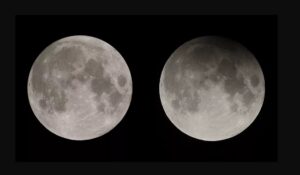Catch a faint penumbral eclipse of the moon this Monday, Nov. 30. In the US, it’ll be early in the morning–4:22 a.m. EST and 1:22 a.m. PST. In Asia, it’ll be in the evening.
More info here and below from Space.com.
A Beaver Full Moon lunar eclipse occurs Monday. Here’s what to expect.
The moon will take 4 hours and 21 minutes to glide across the pale outer fringe (penumbra) of Earth’s shadow, never reaching the shadow’s dark umbra. However, penumbral lunar eclipses are rather subtle events which are usually difficult for most people to detect unless at least 70% of the moon’s diameter is immersed within it.
In this particular case the November full moon, known as a Beaver moon, is going to pass rather deep into the penumbra. In fact, at the moment of the deepest phase/greatest eclipse (09:42 UT) the penumbra will cover 82.9% of the lunar disk. Put another way, the uppermost limb of the moon will be 566 miles (911 kilometers) away from the unseen edge of the much darker umbral shadow of the Earth.
Phases of the Beaver moon lunar eclipse
About 20 minutes prior to the deepest phase of the eclipse, you might see some evidence of this faint penumbral shading on the moon’s upper edge. This corresponds to around 4:22 a.m. EST (0922 GMT); 3:22 a.m. CST; 2:22 a.m. MT and 1:22 a.m. PST. About 70% of the moon’s diameter will be immersed in the penumbra, so any unusual shading on the upper part of the moon should — in theory — be detectable. Some might even detect lesser traces of penumbral shading for some minutes beforehand.
After about 20 minutes, we will arrive at the deepest and most obvious part of the eclipse; the moon’s upper limb should appear sensibly shaded with a light charcoal gray or brownish colored hue.
After the deepest phase has passed, you might be able to perceive a slight darkening or “smudginess” on the moon’s right edge for around 20 additional minutes. So, while the moon will be inside the penumbral shadow for over 260 minutes, most will probably only be aware of it for only about 40 minutes.
The penumbral eclipse will also be detectable from parts of the Caribbean and South America as the moon sets. For observers in east-central Asia, Indonesia and Australia it happens on Monday evening as the moon is rising. At mid-eclipse, the moon will appear in the zenith (directly overhead) over the North Pacific Ocean, not far from the Hawaiian Islands. From the 50th state, greatest eclipse comes late on Sunday night as the long Thanksgiving holiday weekend winds down, at 11:42 p.m. Hawaii Time.
